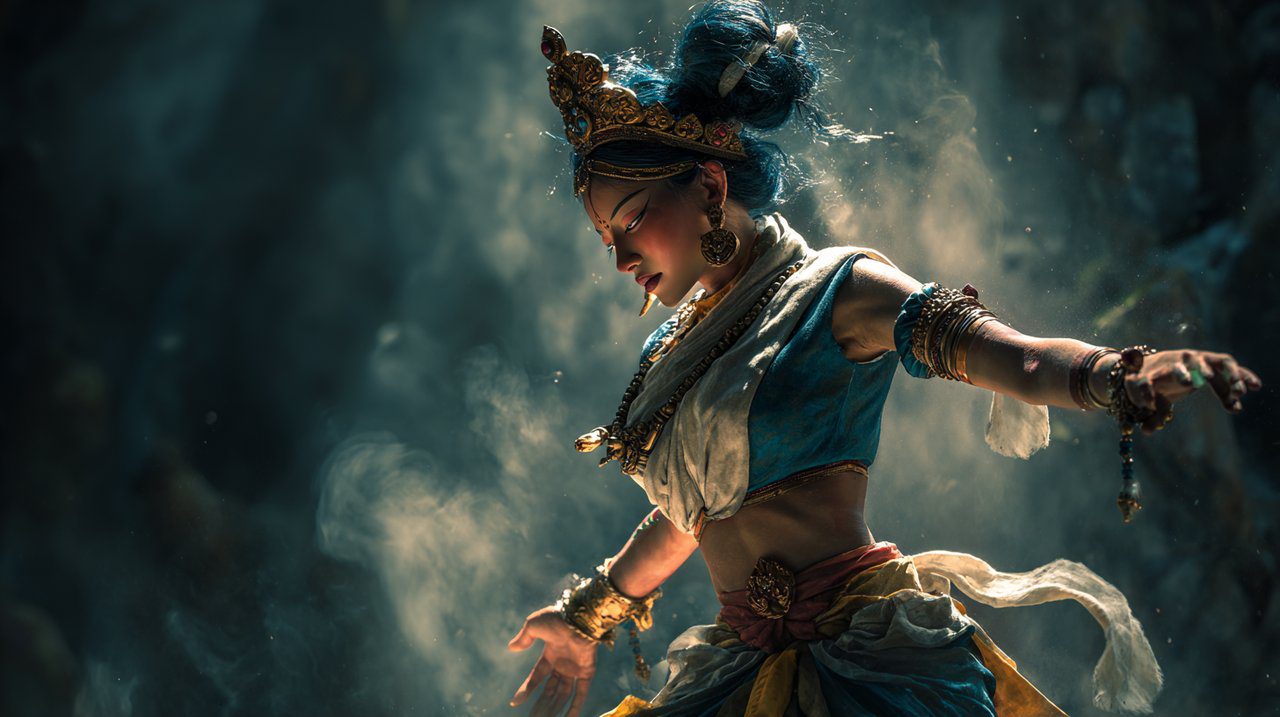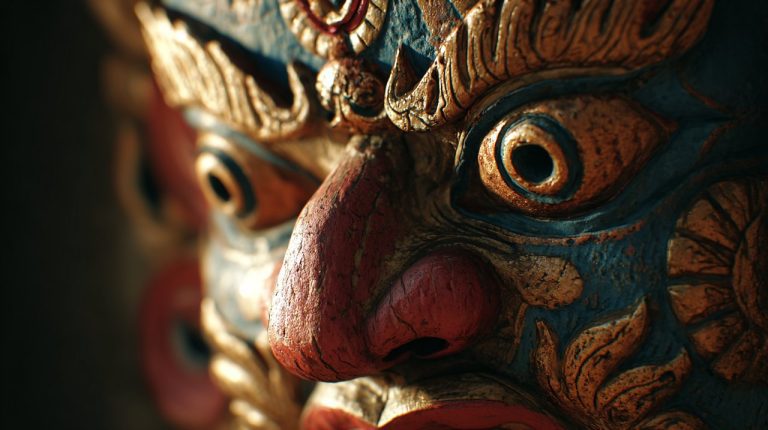The Unbound Spirit: Understanding the Dakinis of Vajrayana Buddhism
When we envision enlightenment, we often picture a gentle, serene unfolding. But what if awakening could also manifest with a fierce, untamed energy?
Many spiritual traditions highlight tranquility and gradual ascent. Yet, within Vajrayana Buddhism, the Dakinis offer a compelling counter-narrative. They embody a vibrant, active wisdom that slices through delusion with remarkable immediacy.
More than just deities, Dakinis are dynamic expressions of wisdom, fierce compassion, and a direct route to liberation. They represent an active, often unconventional, and deeply embodied journey toward awakening.
The Enigmatic Presence of Buddhist Dakinis
To truly understand the Dakinis, we need to look beyond typical spiritual archetypes. They aren’t just goddesses to be observed from a distance.
Instead, Dakinis are living manifestations of enlightened energy, guiding us toward ultimate reality. Their role in Vajrayana Buddhism points to a direct, experiential path.
Think of a wild, untamed river, carving its way through ancient stone. Its currents can be gentle and nurturing, yet also powerful enough to reshape landscapes in an instant. This natural force, operating beyond simple ideas of good or evil, perfectly mirrors the Dakini’s energy.
She brings both profound transformative change and vital life-giving energy, always pushing us towards liberation.
Dakinis: Embodied Wisdom and Liberation
Dakinis embody the very wisdom that leads to awakening. They represent the feminine principle of the enlightened mind, not separate from reality but deeply woven into its fabric.
Their forms, often depicted as both semi-wrathful and joyful, beautifully illustrate the non-dual nature of liberation. This wisdom isn’t just intellectual; it’s an embodied understanding that moves beyond mere conceptual thought.

The Dynamic Feminine Principle in Vajrayana Buddhism
In Vajrayana Buddhism, the feminine principle is defined by wisdom (Prajna) and skillful means (Upaya). Dakinis are the ultimate expression of this powerful interplay.
They represent the intuitive, insightful dimension of awakening that directly perceives the emptiness of all phenomena. This active, intuitive wisdom stands in stark contrast to purely intellectual paths to enlightenment, providing a direct way to cut through delusion.
Diverse Manifestations: Archetypes and Roles
The world of Dakinis is incredibly rich and varied, reflecting the many ways wisdom can manifest. They appear in distinct forms and functions, each serving a unique purpose on the path to awakening.
Understanding these diverse roles helps us truly appreciate their comprehensive influence on spiritual practice.
The Wisdom Dakini: Guides to Ultimate Reality
At their highest expression, Wisdom Dakinis are inseparable from ultimate reality itself. These enlightened beings often represent the pure nature of mind, known as dharmakaya.
They act as guides, revealing the true nature of existence and piercing through the veil of illusion. Their guidance is often direct, challenging, and deeply transformative.
Action Dakinis: Catalysts for Transformation
Action Dakinis are more directly involved in our spiritual journey. They inspire, protect, and help remove obstacles, often appearing in visionary experiences or during meditation.
These Dakinis act as catalysts for spiritual growth, gently but firmly pushing us beyond our comfort zones. Their active engagement helps to dismantle egoic attachments and ignite our inner wisdom.

Earthly Dakinis: Guardians of Sacred Sites and Teachings
Earthly Dakinis are deeply connected to specific places, lineages, and teachings. They are often seen as guardians of sacred sites, hidden treasures (termas), and spiritual practitioners.
These Dakinis bridge the ordinary and the sacred, ensuring the continuity and purity of the Dharma. They serve as a powerful reminder that the sacred is intricately woven into the very fabric of our world.
Engaging with Dakini Energy: Tantric Practices
For those on a spiritual path, engaging with Dakini energy offers a direct route to profound transformation. This involves specific Tantric practices designed to help us internalize their wisdom and power.
It’s not about worshipping an external deity, but rather about recognizing the Dakini principle that resides within each of us.
Dakinis and Tantric Practices: A Path of Direct Experience
Tantric practices involving Dakinis frequently incorporate visualization, mantra recitation, and ritual. Through these methods, practitioners cultivate a deep connection with the Dakini’s unique qualities.
The ultimate goal is to directly experience the non-dual wisdom and compassion that Dakinis embody, emphasizing direct realization over purely intellectual understanding.
The Legacy of Padmasambhava and Dakini Teachings
The legendary master Padmasambhava was instrumental in establishing Buddhism in Tibet. His life and teachings are profoundly intertwined with the Dakinis.
Tradition tells us that Dakinis were his constant companions and teachers, inspiring many of his deepest revelations. Many hidden treasure teachings, known as termas, are also believed to be concealed by Dakinis, patiently awaiting discovery by destined practitioners.
Embracing Fierce Compassion: The Dakini’s Relevance Today
The “fierce” aspect of the Dakini is perhaps her most misunderstood, yet also her most profoundly transformative quality. This isn’t anger born of malice, but a radical, unconditional compassion that simply cannot tolerate illusion.
For us today, this energy offers a powerful tool for navigating life’s complexities.
Consider a moment of intense personal crisis – perhaps a career setback or a relationship challenge – where your familiar comforts crumble. A conventional approach might suggest seeking solace or avoiding discomfort. Yet, internalizing the Dakini’s fearless spirit means facing the raw truth of the situation, cutting through self-deception, and finding the courage to act decisively. This is the fierce compassion that dismantles what no longer serves, clearing the path for genuine growth.

Beyond Conventional Morality: Fierceness as Unconditional Love
The Dakini’s fierceness operates beyond our conventional notions of good and bad. It’s a wisdom that eradicates ignorance and attachment, much like a surgeon’s precise cut removes a tumor to save a life.
This isn’t aggression, but a relentless, unconditional love for truth and liberation. It challenges us to look beyond superficial appearances and see what truly matters.
Cultivating Inner Dakini Wisdom: Intuition and Empowerment
Cultivating inner Dakini wisdom means nurturing our intuition, courage, and a readiness to confront both inner and outer obstacles. It’s about trusting our deepest knowing and acting with unwavering integrity.
This inner empowerment allows us to respond to challenges with clarity and inner strength, rather than reacting from fear or doubt. The Dakini, in essence, invites us to awaken our own innate wisdom and compassion.
So, we return to our opening question: Is enlightenment always gentle? The journey with the Dakinis clearly shows us that the path to awakening isn’t always linear or serene. It’s a vibrant, dynamic engagement with wisdom and fierce compassion that dismantles illusions and truly liberates the spirit.
Their presence reminds us that genuine liberation often calls for a radical embrace of the untamed, intuitive forces within ourselves. This profound understanding can powerfully illuminate your own spiritual journey, offering a deep wellspring of inner strength and clarity.
To explore these transformative energies further, consider practices that connect you with the vibrant, discerning wisdom of the feminine principle in Buddhist thought.
💡 Frequently Asked Questions
In Vajrayana Buddhism, Dakinis are not just deities but dynamic manifestations of enlightened energy, fierce compassion, and active wisdom. They represent a direct and embodied route to liberation, embodying a vibrant, untamed force that slices through delusion, contrasting with more conventional, tranquil spiritual archetypes.
Dakinis embody wisdom (Prajna) and skillful means (Upaya), representing the feminine principle of the enlightened mind. Their forms, often depicted as semi-wrathful and joyful, illustrate the non-dual nature of liberation. The 'fierce' aspect is not malice but a radical, unconditional compassion that relentlessly cuts through illusion and attachment, dismantling what no longer serves for genuine growth.
The text describes three main categories: Wisdom Dakinis, who are inseparable from ultimate reality and guide practitioners to the true nature of existence; Action Dakinis, who inspire, protect, and help remove obstacles, acting as catalysts for spiritual growth; and Earthly Dakinis, who are guardians of sacred sites, lineages, and teachings, bridging the ordinary and the sacred.
Engaging with Dakini energy involves specific Tantric practices such as visualization, mantra recitation, and ritual. The aim is not external worship but recognizing the Dakini principle within oneself and cultivating a deep connection to their wisdom and power for direct experience of non-dual wisdom and compassion.
The legendary master Padmasambhava was deeply intertwined with Dakinis, who were considered his constant companions and teachers, inspiring many of his revelations. Many hidden treasure teachings (termas) are also believed to have been concealed by Dakinis, awaiting discovery by destined practitioners.








